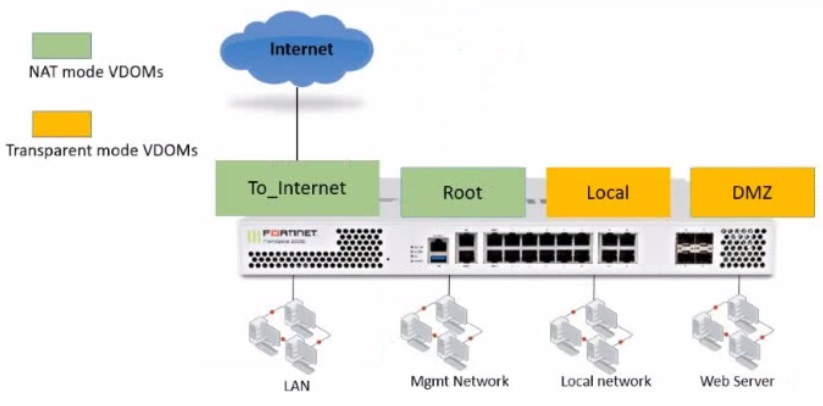Fortinet NSE 4 - FortiOS 7.2 NSE4_FGT-7.2 Exam Practice Test
Refer to the exhibit.

The Root and To_Internet VDOMs are configured in NAT mode. The DMZ and Local VDOMs are configured in transparent mode.
The Root VDOM is the management VDOM. The To_Internet VDOM allows LAN users to access the internet. The To_Internet VDOM is the only VDOM with internet access and is directly connected to ISP modem .
With this configuration, which statement is true?
Answer : A
If the Services field is configured in a Virtual IP (VIP), which statement is true when central NAT is used?
Answer : C
Refer to the exhibit.

Which contains a session list output. Based on the information shown in the exhibit, which statement is true?
Answer : B
FortiGate_Security_6.4 page 155 . In one-to-one, PAT is not required.
Which two settings are required for SSL VPN to function between two FortiGate devices? (Choose two.)
Answer : C, D
To establish an SSL VPN connection between two FortiGate devices, the following two settings are required:
The server FortiGate requires a CA certificate to verify the client FortiGate certificate: The server FortiGate will use a CA (Certificate Authority) certificate to verify the client FortiGate certificate, ensuring that the client device is trusted and allowed to establish an SSL VPN connection.
The client FortiGate requires the SSL VPN tunnel interface type to connect SSL VPN: The client FortiGate must have an SSL VPN tunnel interface type configured in order to establish an SSL VPN connection. This interface type will be used to connect to the server FortiGate over the SSL VPN.
Which two statements are correct about NGFW Policy-based mode? (Choose two.)
Answer : C, D
How does FortiGate act when using SSL VPN in web mode?
Refer to the exhibit.

The exhibit displays the output of the CLI command: diagnose sys ha dump-by vcluster.
Which two statements are true? (Choose two.)
Answer : A, D
1. Override is disable by default - OK
2. 'If the HA uptime of a device is AT LEAST FIVE MINUTES (300 seconds) MORE than the HA Uptime of the other FortiGate devices, it becomes the